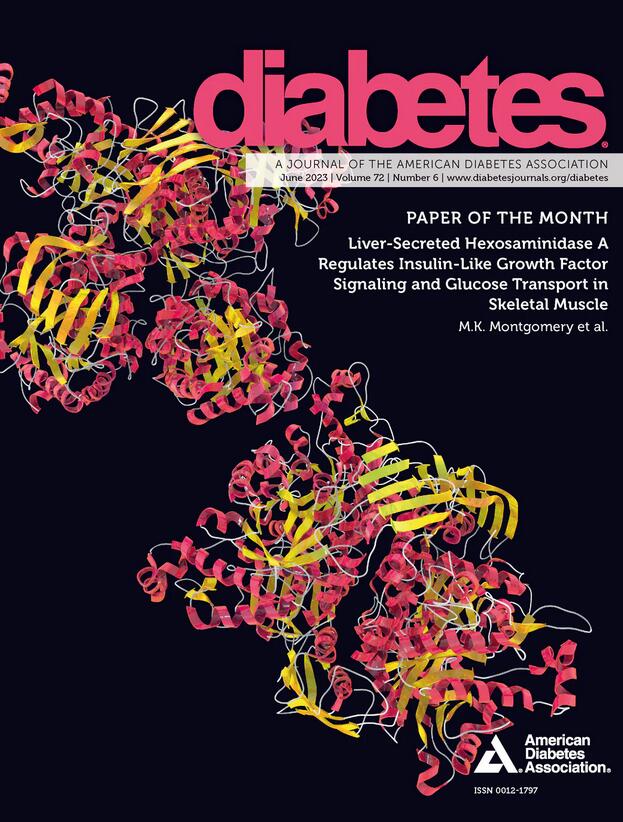Proteogenomic Discovery of Novel Open Reading Frames With HLA Immune Presentation on Human β-Cells
IF 7.5
1区 医学
Q1 ENDOCRINOLOGY & METABOLISM
引用次数: 0
Abstract
Ribosome profiling (Ribo-seq) measures translational regulation and reveals novel or unannotated open reading frames (nuORFs) otherwise difficult to identify. Recent reports demonstrate that nuORFs regulate gene expression and immune recognition, highlighting their emerging biological roles. Pancreatic β-cells are critical for maintaining euglycemic conditions, and β-cell impairment contributes to diabetes development. Identification of nuORF and protein/peptide products in human β-cells could reveal novel mechanisms that regulate β-cell function during homeostatic and disease conditions. Here, we applied a proteogenomic approach to human β-cells to define previously unknown protein/peptide products. First, we applied cell type–specific Ribo-seq to map the translatome of human stem cell–derived β-cells (sBCs). Pathways crucial for β-cell function and antigen presentation were subject to translational regulation. We detected a recently described immunogenic neoantigen, INS-DRiP, presumably originating from a downstream start site in INS mRNA. Moreover, our analysis revealed 965 novel nuORFs in sBCs, with a majority showing protein-level support. Comparison with primary human islets further validated nuORF translation and highlighted β-cell specificity. We identified a novel, primate-specific regulatory upstream ORF within TYK2, which is crucial for β-cell function and interferon response and has many variants strongly associated with type 1 diabetes. Finally, we used immunopeptidomics, HLA-binding prediction models, and T-cell coculture assays to validate the presentation and immunogenicity of preproinsulin peptides and nuORFs. Our findings underscore the importance of translational regulation in β-cell function and provide an important resource to the diabetes research community. ARTICLE HIGHLIGHTS We developed a cell type–specific proteogenomic approach to reveal novel or unannotated open reading frames (nuORFs) using transcriptomics, ribosomal profiling, and proteomic analysis of human pancreatic β-cells using stem cell–derived β-cells and/or cadaveric islets. Our analysis revealed translational regulation of β-cell–specific pathways during differentiation and identified 965 nuORFs, with a majority exhibiting protein support and substantial β-cell specificity. A primate-specific ORF located in the 5′ untranslated region of the type 1 diabetes risk gene TYK2 may act as a translational activator. We provide HLA class I immunopeptidomic data from cytokine-stimulated human β-cells and demonstrate their utility in coculture assays with autoreactive T-cell transductants. Taken together, our results define the human β-cell translatome, an important resource to the research field.人类β细胞HLA免疫呈递的新型开放阅读框架的蛋白质基因组学发现
核糖体分析(Ribo-seq)测量翻译调控,揭示新的或未注释的开放阅读框(nuorf),否则难以识别。最近的报道表明,nuorf调节基因表达和免疫识别,突出了它们的新生物学作用。胰腺β细胞对维持血糖水平至关重要,而β细胞受损会导致糖尿病的发生。鉴定人类β细胞中的nuORF和蛋白/肽产物可以揭示在稳态和疾病条件下调节β细胞功能的新机制。在这里,我们将蛋白质基因组学方法应用于人类β细胞,以确定以前未知的蛋白质/肽产物。首先,我们应用细胞类型特异性核糖核酸序列(Ribo-seq)绘制了人类干细胞衍生β细胞(sbc)的翻译组。对β细胞功能和抗原呈递至关重要的途径受到翻译调节。我们检测到最近描述的免疫原性新抗原INS- drip,可能起源于INS mRNA的下游起始位点。此外,我们的分析在sbc中发现了965个新的nuorf,其中大多数显示出蛋白质水平的支持。与原代人胰岛的比较进一步证实了nuORF的翻译,并强调了β细胞特异性。我们在TYK2中发现了一个新的,灵长类特异性调控的上游ORF,它对β细胞功能和干扰素反应至关重要,并且有许多变体与1型糖尿病密切相关。最后,我们使用免疫肽组学、hla结合预测模型和t细胞共培养实验来验证胰岛素前原肽和nuorf的呈现和免疫原性。我们的发现强调了β细胞功能中翻译调控的重要性,并为糖尿病研究界提供了重要的资源。我们开发了一种细胞类型特异性蛋白质基因组学方法,利用转录组学、核糖体分析和人类胰腺β细胞的蛋白质组学分析,利用干细胞来源的β细胞和/或尸体胰岛,揭示新的或未注释的开放阅读框架(nuorf)。我们的分析揭示了分化过程中β细胞特异性途径的翻译调控,并鉴定出965个nuorf,其中大多数表现出蛋白质支持和显著的β细胞特异性。位于1型糖尿病风险基因TYK2 5 '非翻译区的灵长类特异性ORF可能作为翻译激活因子。我们提供了来自细胞因子刺激的人β细胞的HLA I类免疫肽组学数据,并证明了它们在与自身反应性t细胞转导剂共培养试验中的实用性。综上所述,我们的结果定义了人类β细胞翻译组,这是研究领域的重要资源。
本文章由计算机程序翻译,如有差异,请以英文原文为准。
求助全文
约1分钟内获得全文
求助全文
来源期刊

Diabetes
医学-内分泌学与代谢
CiteScore
12.50
自引率
2.60%
发文量
1968
审稿时长
1 months
期刊介绍:
Diabetes is a scientific journal that publishes original research exploring the physiological and pathophysiological aspects of diabetes mellitus. We encourage submissions of manuscripts pertaining to laboratory, animal, or human research, covering a wide range of topics. Our primary focus is on investigative reports investigating various aspects such as the development and progression of diabetes, along with its associated complications. We also welcome studies delving into normal and pathological pancreatic islet function and intermediary metabolism, as well as exploring the mechanisms of drug and hormone action from a pharmacological perspective. Additionally, we encourage submissions that delve into the biochemical and molecular aspects of both normal and abnormal biological processes.
However, it is important to note that we do not publish studies relating to diabetes education or the application of accepted therapeutic and diagnostic approaches to patients with diabetes mellitus. Our aim is to provide a platform for research that contributes to advancing our understanding of the underlying mechanisms and processes of diabetes.
 求助内容:
求助内容: 应助结果提醒方式:
应助结果提醒方式:


